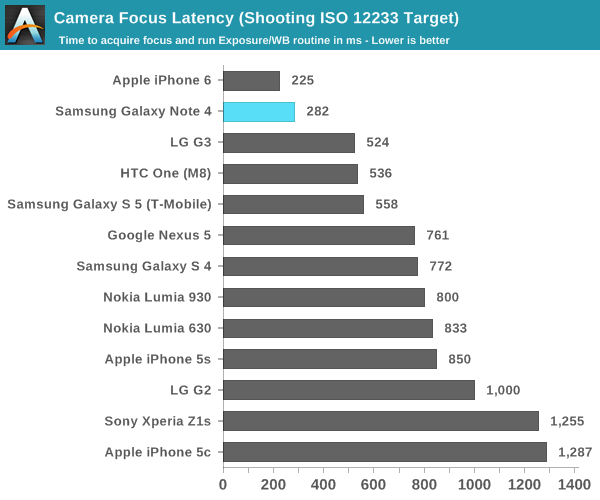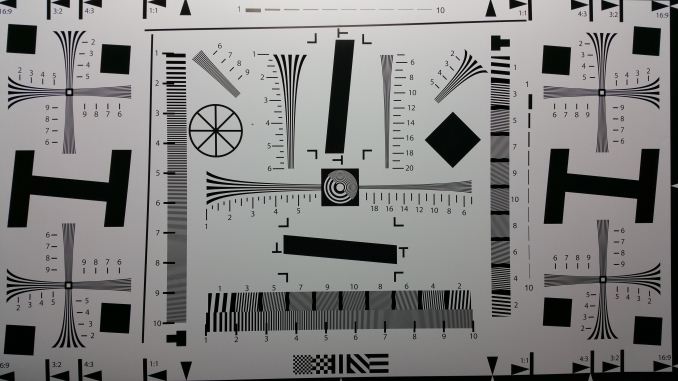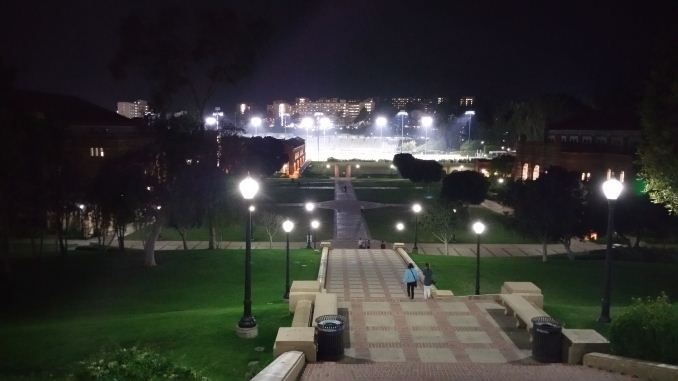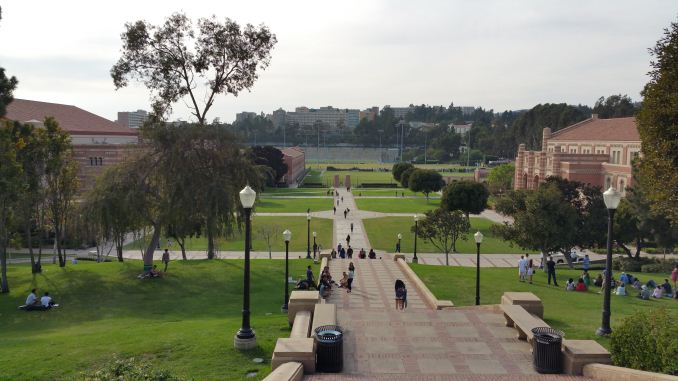The Samsung Galaxy Note 4 Review
by Joshua Ho on October 15, 2014 9:00 AM EST- Posted in
- Smartphones
- Samsung
- Android
- Mobile
- Galaxy Note 4
Camera
While the 16MP camera of the Galaxy Note 4 is mostly what we would expect, Samsung has really changed things up with the addition of OIS. Outside of this addition and the Sony IMX240 sensor, there’s really not a lot of change when it comes to the Galaxy Note 4. This means that we see the same 31mm equivalent focal length and F/2.27 aperture. At this point, it seems that OIS has finally reached mainstream adoption as both Samsung and Apple are shipping OIS solutions on their phones. The front facing camera is noticeably different though, with a Samsung S5K6D1YX sensor that I haven't seen elsewhere.
However, before we get into the proper image quality analysis I wanted to first cover shot to shot latency and focus/AE latency, as both are critical to a good image capture experience. Even if it’s possible to get amazing photos from a camera, it doesn’t really matter if the moment is missed. In order to test this, we look at the ideal case, which is when the phone is pointed at the ISO chart with bright lighting to maximize contrast.


As one can see in the graphs above, capture latency and focus latency are quite competitive with on the Note 4. However, there is one crucial detail that the focus latency graph misses, which is that Samsung doesn’t have continuous auto-focus in preview with the Note 4. As a result, there’s realistically an additional latency period before the auto-focus begins to run. The result is that the total time from out of focus to in focus is realistically closer to 800ms, but if one immediately taps the display to begin an AF run it’s possible to achieve the lower bound value, which is just south of 300ms.
Still Image Performance
While I'm still working on moving towards a better test for cameras, for now we have our standard photo comparisons that should give a good idea of what to expect from a smartphone camera in comparison to other cameras. Our first test is the standard ISO chart, which allows for a good test of maximum resolution.

For this first test, it seems that Samsung hasn't really changed much when it comes to maximum resolution, and in general the Note 4 produces similar output to the Galaxy S5. To verify this and a test of dynamic range, we'll look at a landscape shot next.
In this test, we see that the Galaxy Note 4 generally does well with detail and dynamic range as the landscape is generally well-detailed, although there's quite a bit of detail that seems to be smudged away on the grass as it seems to be a flat green texture for the most part. There's also noticeable color artifacting on the bleachers in the distance. We'll look at the same scene in low light to get a better idea for what the Note 4 really brings to the table.
Here, in low light we see significant improvements in image quality when comparing the Galaxy S5 to the Galaxy Note 4. The iPhone 6 Plus and Note 4 are quite close in overal quality, but looking at the brick building on the right of the image shows that the iPhone 6 Plus is maintaining a higher level of detail in this scene.
In the case of HDR, Samsung continues to do a great job with their implementation. For the most part this feature is successfully implemented with no real halos or other artifacts even when there are moving objects in the shot. This is likely to be implemented through on-sensor HDR rather than image combination.





































195 Comments
View All Comments
akdj - Thursday, October 30, 2014 - link
Sorry. Something was lost in translation there;)I'm not going to go tbrough the dozen+ grammatical and punctuation errors, but my point was to compare iOS to Android with their siblings ...the Chromebook and OS X. Windows has the same if they're able to finally figure phones out! The SPIII is a HELLUVA design and enough difference between itself and the iPad (including the price, you're looking more like comparing a nice 13" rMBP w/Haswell ans Iris Pro graphics;))
Vertical and horizontal support. iOS and OS X with continuity and handoff being another extension of Airdrop is absolutely incredible!
The new near 15million pixel 5K iMac is a Grand Slam
iPad Air 2, it's A8X, a 2 and a ½ gen old 64 bit design---2GB of RAM, & a buck 28 built in with a half million 'optomized' tablet apps for everything from photo and video manipulation with Adobe, MS, & OS X integrated and aggregated alls to music creation, mixing and mastering ...magazines that are mind blowing, killer browser choices and unbelievably powerful video editing suites, drawing and sketching programs...old 'Chilton' fix 'em up guides or ForeFlight to file your F/P n tell ya how much gas you should pump in, while it considers diversions and real time weather and traffic. TCAS ans ADSB ...Jep charts, plates and updates in 'now' time, THAT'S a 'Tool!'
Farting around with ROMS is like rewiring your microwave. Why? It's to cook, melt, boil, or pop your F'ung popcorn!
tipoo - Wednesday, October 15, 2014 - link
Indeed. I'm excited for Nvidias Denver CPU cores, finally someone else going with two big cores rather than four small.mpokwsths - Wednesday, October 15, 2014 - link
Something is not right here..."Around 450 nits" with auto brightness on???
Displaymate strongly disagrees with Anandtech. They measured "478 - 750 cd/m2" with auto brightness (1 nit = 1 cd/m2)
http://www.displaymate.com/Galaxy_Note4_ShootOut_1...
melgross - Wednesday, October 15, 2014 - link
There is variability in production. The differences you are seeing are well within that variability.mpokwsths - Wednesday, October 15, 2014 - link
Don't be ridiculous, please...Displaymate: "When Automatic Brightness is turned On, the Galaxy Note 4 reaches an impressive 750 cd/m2 in High Ambient Light, where high Brightness is really needed – it is the brightest mobile display that we have ever tested"
It is an out-of-space claim that there can be a variability in production of a 70% level...
tralalalalalala40 - Saturday, October 18, 2014 - link
hopefully the display doesn't keep that brightness very long. those pentile pixels will burn out. you'll have to use a screen saver.theduckofdeath - Thursday, October 16, 2014 - link
Sounds like a poor excuse for inaccurate testing to me. If the error margin was that huge, the display would be horrible to look at.JoshHo - Wednesday, October 15, 2014 - link
In practice I find that the 100% APL value is more representative of the perceived brightness, this is due to a difference in testing methodology.Pissedoffyouth - Wednesday, October 15, 2014 - link
I just bought a note 3, and I'm more than happy with it with a zerolemon 10000mah battery. This doesn't really offer much more really, more of an slight upgrade.I'd be interested to see why they didn't up the battery a little more considering they made the chassis bigger...
darkich - Wednesday, October 15, 2014 - link
I find it impossible not to notice the Apple reality distortion effect in this article.But nice try hiding it, AT.
I'll just state a fact proven by pretty much every other review - battery endurance on this device is clearly better than that on the iPhone 6+.